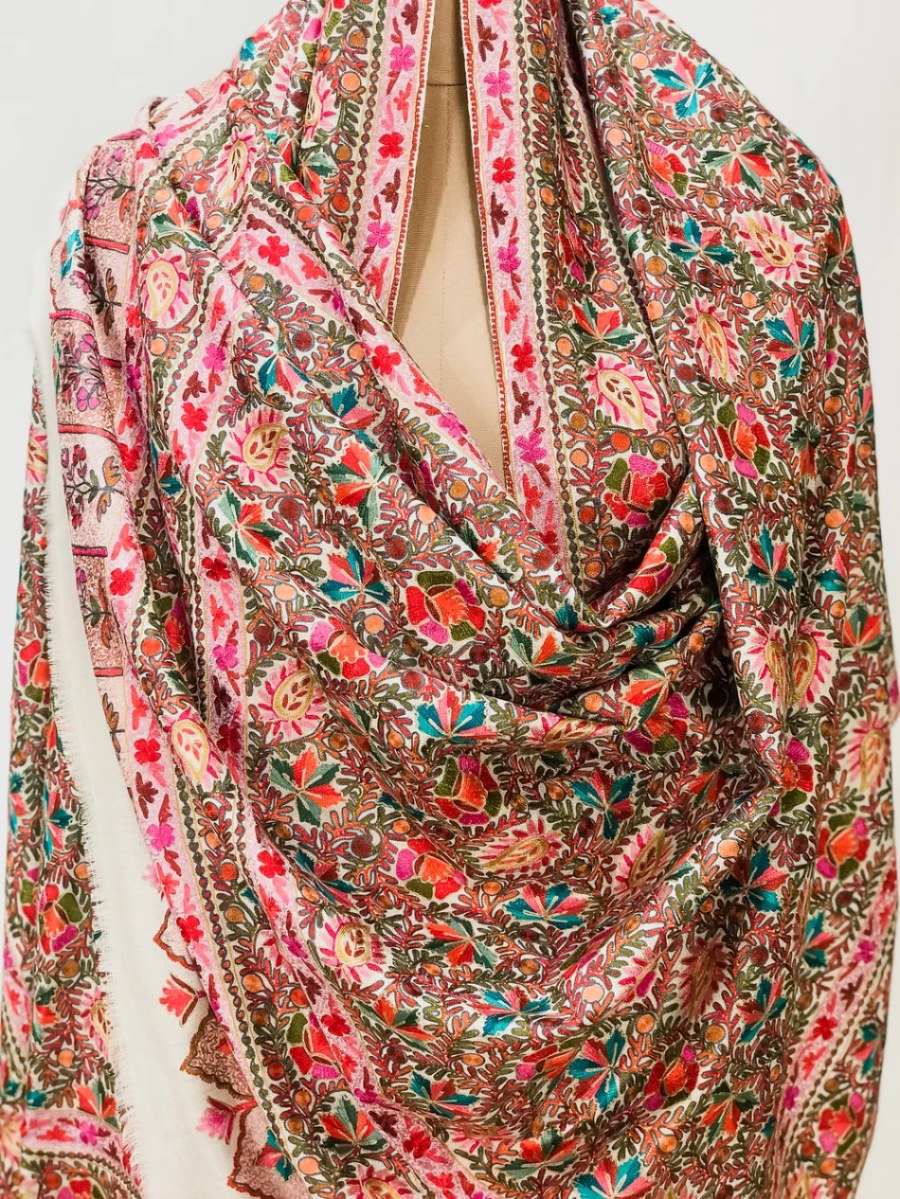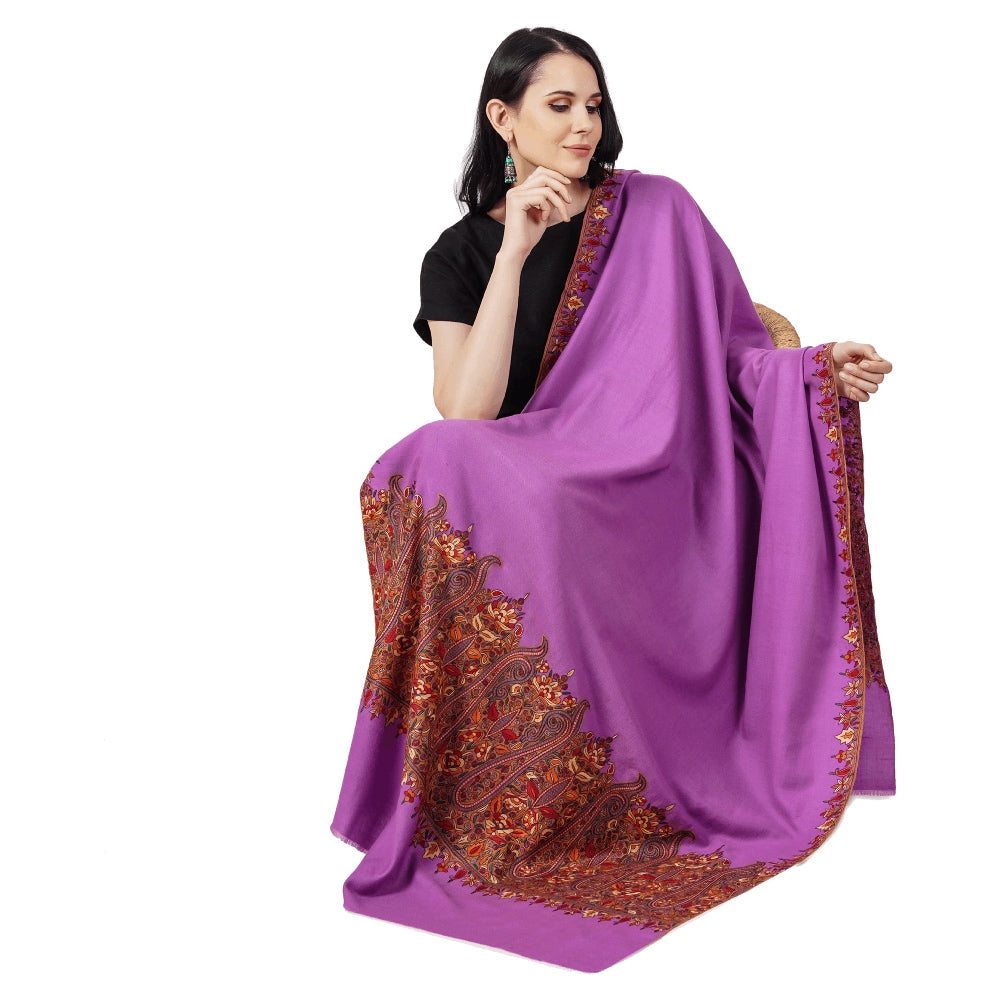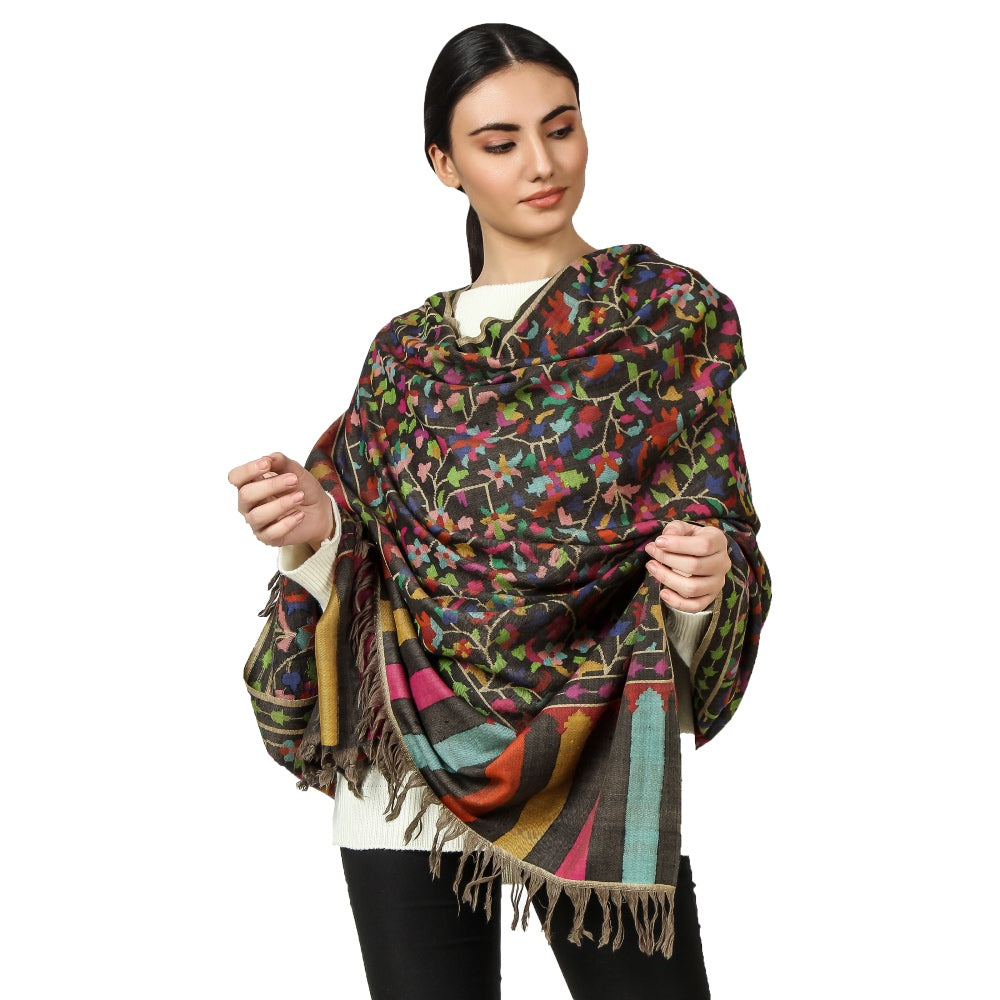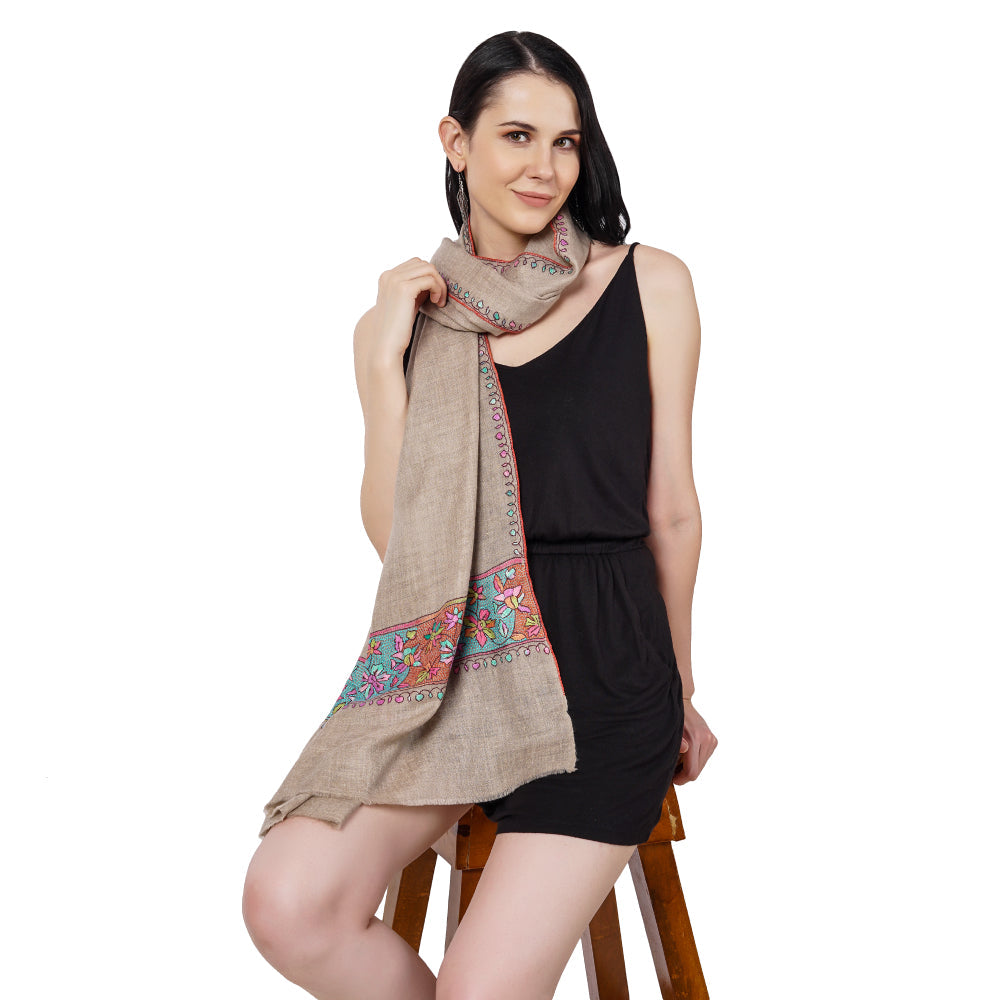
Who introduced Kashmiri Shawls in Kashmir?
Share
Kashmiri shawls are a type of traditional Indian shawl made from fine wool or pashmina. These shawls are known for their intricate embroidery, beautiful patterns, and exquisite craftsmanship. Kashmiri shawls have a rich history and cultural significance, making them one of the most coveted items of clothing in India and beyond.
The history of Kashmiri shawls can be traced back to the 3rd century BCE, when shawls were first introduced in Central Asia. The shawls were made from the wool of a particular breed of goat called Changthangi, which is native to the Himalayan region. These shawls were highly prized for their warmth and durability, and were often used as a form of currency.

During the Mughal era in India (16th-19th century), the emperors and empresses were particularly fond of Kashmiri shawls, and would often gift them to foreign dignitaries. This led to an increase in demand for Kashmiri shawls in Europe, where they became a symbol of luxury and wealth.
Over time, Kashmiri shawls evolved and developed, with new designs and techniques being introduced. Today, the shawl-weaving industry in Kashmir is a vital part of the local economy, and Kashmiri shawls are sold all over the world.
Despite the popularity of Kashmiri shawls, the industry has faced challenges in recent years, with competition from cheaper, mass-produced imitations and the threat of climate change affecting the production of Changthangi wool. Nevertheless, efforts are being made to preserve the traditional techniques and designs of Kashmiri shawls, ensuring that this cultural heritage endures for generations to come.
Origins of Shawls in Central Asia
The origins of shawls can be traced back to Central Asia, where they were first made over 2000 years ago. The ancient Persians and Greeks were known to have used shawls, which were made from the wool of local goats. Over time, shawls became a popular form of clothing across Central Asia, with different regions developing their own unique styles and techniques.
The Silk Road played a significant role in the spread of shawls across Central Asia. The Silk Road was a vast network of trade routes that connected China with the Mediterranean region, and was used for centuries to transport goods such as silk, spices, and precious metals. Along these trade routes, shawls were traded and exchanged, and the art of shawl-making spread to new regions.

It is believed that shawls were first introduced to Kashmir in the 15th century, when the ruler of Kashmir, Zain-ul-Abidin, invited skilled weavers from Central Asia to come and settle in the region. These weavers brought with them their knowledge of shawl-making, and helped to establish the shawl-weaving industry in Kashmir.
The shawls produced in Kashmir were made from the wool of the Changthangi goat, which is native to the region. This wool is known for its fine texture, softness, and warmth, making it ideal for making shawls. Kashmiri weavers soon began to develop their own unique styles and designs, incorporating local motifs and patterns into their work.
The popularity of Kashmiri shawls grew over time, with Mughal emperors and empresses becoming particularly fond of them. The shawl-weaving industry in Kashmir flourished, with skilled weavers producing intricate and beautiful shawls that were highly sought after across India and beyond. Today, Kashmiri shawls continue to be regarded as one of the finest examples of traditional Indian textiles, and are a testament to the enduring legacy of Central Asian shawl-making.
Also read: Which Animal wool is used to produce Pashmina Shawls?
Mughal Era and Kashmiri Shawls
The Mughal era in India (16th-19th century) was a period of great cultural and artistic flourishing, and Kashmiri shawls played an important role in this. Mughal emperors and empresses were known for their patronage of the arts, and Kashmiri shawls were no exception.

The Mughal emperors were particularly fond of Kashmiri shawls, and would often gift them to foreign dignitaries as a sign of their wealth and power. The emperors also wore Kashmiri shawls themselves, using them as a form of royal attire. In fact, the famous Mughal emperor Akbar the Great was said to have owned over 1,000 Kashmiri shawls!
The Mughal empresses were also instrumental in popularizing Kashmiri shawls. They would wear the shawls as a form of clothing, using them to drape over their heads and shoulders. The empresses would often commission new designs and patterns for their shawls, and their choices would set the trends for the rest of the court.
The Mughal era saw the development of the shawl-weaving industry in Kashmir. Skilled weavers from Central Asia had settled in Kashmir during the 15th century, and had brought with them their knowledge of shawl-making. Over time, Kashmiri weavers began to develop their own unique styles and designs, incorporating local motifs and patterns into their work.
The Mughal emperors and empresses provided a great boost to the Kashmiri shawl industry, by commissioning new designs and patterns and creating a market for the shawls. The shawl-weaving industry in Kashmir became a vital part of the local economy, with weavers producing shawls of the finest quality and craftsmanship.
Today, Kashmiri shawls remain one of the finest examples of traditional Indian textiles, and are highly prized for their beauty and exquisite craftsmanship. The Mughal era played a significant role in the development of the Kashmiri shawl industry, and its legacy endures to this day.
Also read: The History of Pashmina Shawls
European Demand and Kashmiri Shawls
European fascination with Kashmiri shawls began in the 17th century, when European traders first encountered the shawls in India. The shawls were unlike anything they had seen before, with their intricate patterns and luxurious feel. European merchants quickly recognized the commercial potential of the shawls, and began to trade them in large quantities.

Kashmiri shawls soon became fashionable among the European aristocracy, who saw them as a sign of refinement and taste. They were particularly popular in France, where they became known as "cashmere" shawls (a misnomer, as they were actually made from the wool of the Changthangi goat in Kashmir). Wealthy European women began to wear the shawls as a fashion accessory, draping them over their shoulders or using them as a wrap.
European fashion had a significant influence on the design of Kashmiri shawls. As the shawls became more popular in Europe, Kashmiri weavers began to incorporate European motifs and patterns into their designs. This led to a fusion of styles, with traditional Kashmiri patterns and motifs being combined with European elements such as floral patterns and geometric shapes.
The demand for Kashmiri shawls in Europe had a profound impact on the Kashmiri shawl industry. The shawls became a major export for Kashmir, with merchants from all over Europe coming to buy them. The shawl-weaving industry in Kashmir boomed, with weavers producing shawls of even higher quality and craftsmanship to meet the demand.
However, the European demand for Kashmiri shawls also had some negative consequences. The high demand led to overproduction and the decline in quality, as manufacturers began to use cheaper materials and shortcuts to keep up with the demand. The European demand for Kashmiri shawls also led to the exploitation of Kashmiri workers, who were paid very low wages despite the high prices that the shawls commanded in Europe.
Overall, the European demand for Kashmiri shawls had a mixed impact on the Kashmiri shawl industry. While it brought about great prosperity and innovation, it also led to exploitation and the decline in quality. However, the legacy of European fascination with Kashmiri shawls endures to this day, with the shawls remaining a symbol of luxury and elegance.
Technological Advancements and Kashmiri Shawls
Over the years, the Kashmiri shawl industry has undergone numerous technological advancements, which have contributed to the quality and beauty of the shawls. One major innovation was the development of new techniques for shawl weaving. Kashmiri weavers are known for their intricate embroidery and fine woolen weaving, but with the advent of new technology, they were able to create even more intricate patterns and designs.

Another significant advancement was the introduction of new dyeing and printing methods. Traditional Kashmiri shawls were typically dyed in a limited range of colors, but with new dyeing techniques, weavers were able to create more vibrant and diverse colors. Additionally, printing methods such as screen printing and digital printing allowed for greater precision and complexity in the designs.
The introduction of new materials has also contributed to the evolution of Kashmiri shawls. While traditional shawls were made exclusively from wool, modern shawls incorporate a range of materials such as silk, cotton, and pashmina (a type of fine cashmere wool). These materials not only add to the richness and beauty of the shawls but also make them lighter and more comfortable to wear.
Overall, these technological advancements have greatly enhanced the quality and beauty of Kashmiri shawls, making them even more sought-after and valuable. However, there is also a concern that the increased use of technology may lead to a loss of traditional craftsmanship and skills. Therefore, it is important to strike a balance between tradition and innovation to ensure that the unique beauty and quality of Kashmiri shawls are preserved for future generations.
Evolution of Kashmiri Shawls
The Kashmiri shawl has undergone many changes in its design and patterns over the years. The traditional paisley pattern, which is still popular today, was originally influenced by Persian designs. However, over time, the design of Kashmiri shawls has evolved to incorporate a range of other motifs such as flowers, leaves, and animals. Today, Kashmiri shawls are available in a wide variety of designs and colors, ranging from the traditional to the modern.

The market for Kashmiri shawls has also undergone significant shifts over time. In the past, shawls were primarily worn by the wealthy and were often used as a status symbol. However, as the shawl industry grew, the market expanded to include people from all walks of life. Today, Kashmiri shawls are available in a wide range of prices, making them accessible to people with different budgets.
The adaptation of shawls to changing fashion trends has also played a role in the evolution of Kashmiri shawls. In the 19th century, the European demand for Kashmiri shawls influenced the design of shawls in Kashmir. This led to the creation of lighter weight shawls that were better suited for the European climate. Today, Kashmiri shawls are still influenced by global fashion trends, but they also retain their unique Kashmiri identity.
Despite these changes, the Kashmiri shawl remains a timeless and elegant accessory. It is a symbol of Kashmiri craftsmanship and culture, and its beauty and quality continue to be appreciated by people around the world.
Contemporary Kashmiri Shawls
The Kashmiri shawl industry has undergone significant changes in recent years, with increased competition from other textile industries and changes in consumer preferences. However, the industry continues to play an important role in the Kashmiri economy, providing employment opportunities to thousands of people.
One of the major challenges facing the Kashmiri shawl industry is the availability of raw materials. The production of high-quality wool, silk, and other materials required for shawl making has become increasingly difficult due to environmental changes and competition from other industries. This has led to a decline in the quality of some Kashmiri shawls, and in some cases, an increase in the use of synthetic materials.
Another challenge facing the industry is the competition from other textile industries. The rise of fast fashion and mass-produced textiles has led to a decline in the demand for traditional, handmade products like Kashmiri shawls. As a result, many artisans and weavers are struggling to make a living.
Despite these challenges, there are efforts underway to preserve traditional techniques and designs. Many organizations and individuals are working to promote the use of high-quality, locally-sourced materials and to preserve traditional dyeing and weaving methods. They are also working to educate consumers about the importance of supporting traditional crafts and industries like the Kashmiri shawl industry.
Overall, the future of the Kashmiri shawl industry remains uncertain, but there is hope that with continued efforts to preserve traditional techniques and designs, the industry can continue to thrive and contribute to the rich cultural heritage of Kashmir.
Significance of Kashmiri Shawls
Kashmiri shawls have a significant cultural and historical importance in Kashmir and beyond. They have been an integral part of Kashmiri society for centuries, and their intricate designs and patterns are deeply symbolic and meaningful. Kashmiri shawls were historically used as a sign of wealth and status, and were often given as gifts or used in important ceremonies and events.

The designs of Kashmiri shawls often feature intricate floral and paisley patterns, as well as geometric shapes and abstract designs. These designs have deep symbolic meanings, with each pattern representing a different aspect of Kashmiri culture and society. For example, the paisley pattern is said to represent the mango fruit, which is a symbol of life and fertility in Kashmiri culture.
Shawls also play an important role in Kashmiri society today, with many people continuing to wear them as a symbol of their cultural heritage. The shawl industry is also an important source of income for many families in Kashmir, particularly those in rural areas where traditional crafts are still practiced.
Some commonly used materials in the production of Kashmiri shawls include pashmina, a fine wool fiber, as well as silk and cotton. The process of making a Kashmiri shawl can take several months, as each one is made entirely by hand using traditional techniques like spinning, dyeing, and weaving.
While the demand for Kashmiri shawls has declined in recent years due to competition from other textile industries and changing consumer preferences, they remain a unique and treasured part of Kashmiri culture. Efforts to preserve traditional techniques and designs are essential to ensure that this important cultural heritage continues to be celebrated and appreciated for generations to come.
Frequently Asked Questions
-
What materials are used to make Kashmiri shawls?
Kashmiri shawls are traditionally made from pashmina, a fine wool fiber that comes from the underbelly of the Capra Hircus goat. Other materials such as silk and cotton may also be used.
-
How long does it take to make a Kashmiri shawl?
The process of making a Kashmiri shawl is time-consuming and requires great skill and patience. It can take anywhere from several weeks to several months to make a single shawl, depending on its size and complexity.
-
Are Kashmiri shawls still in demand today?
While the demand for Kashmiri shawls has declined in recent years, they remain highly prized for their intricate designs and high-quality craftsmanship. Many people continue to wear them as a symbol of their cultural heritage, and efforts are being made to promote the industry and preserve traditional techniques.
-
What makes Kashmiri shawls unique?
Kashmiri shawls are unique in their intricate designs and high-quality craftsmanship. They are made entirely by hand using traditional techniques that have been passed down through generations of artisans. Each shawl is a work of art, with its own unique design and symbolism.
X. Conclusion
In conclusion, Kashmiri shawls have a rich cultural and historical significance in Kashmir and beyond. They are not just a piece of clothing, but a symbol of Kashmiri identity and heritage. Despite the challenges facing the industry, efforts are being made to preserve traditional techniques and designs and promote the continued appreciation and celebration of this important cultural heritage. By valuing and supporting the Kashmiri shawl industry, we can ensure that this beautiful and unique art form continues to thrive for generations to come.




